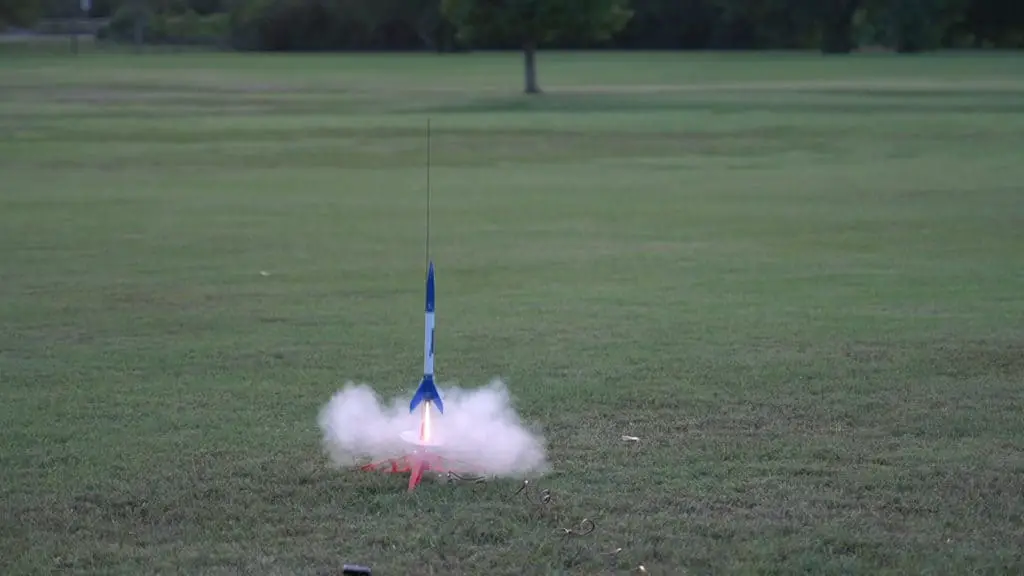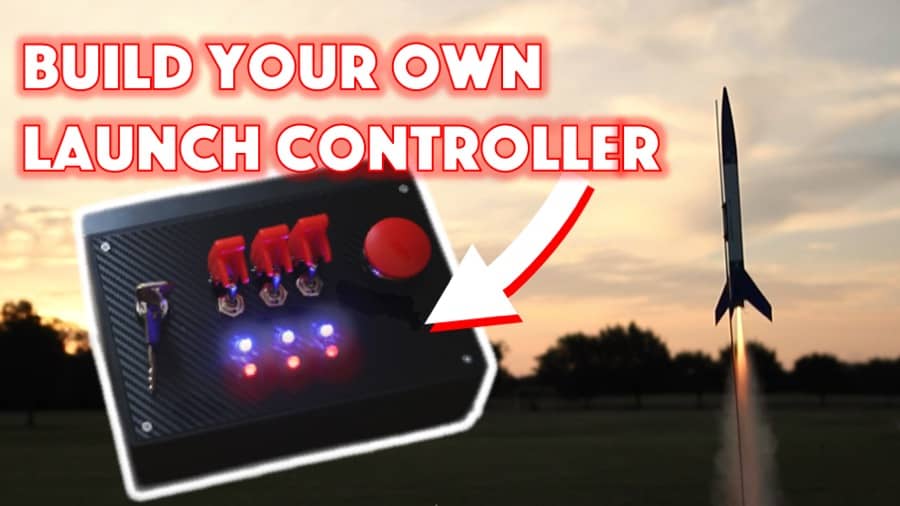
Model rocket fins are one of the most important parts of a rocket’s anatomy and can determine whether the rocket flies correctly at all. While fins vary widely in shape and size depending on the rocket they’re attached to, they are almost always present.
Model rocket fins at the base of the rocket stabilize and guide a rocket’s flight trajectory by creating a center of pressure that is aft (rearward) of its center of gravity. Fins are built in various designs that optimize stability and drag to create the desired flight characteristics of the rocket.
This introductory guide will go over the different concepts related to model rocket fins, such as:
- Model rocket fin shape
- Model rocket fin size
- Model rocket fin placement
- Model rocket fin aerodynamics
- Model rocket fin construction
Whether you make the fins on your model rocket yourself or buy a prefabricated kit, you’ll need to understand the basic concepts of why rocket fins are employed and how they aid in rocket flight. Read on to find out more about model rocket fins and why they’re so important.
Are you still using the standard Estes controllers for your launches?
We just built our own beautiful launch controllers that make launches SO much more fun, and we documented EVERY single step and item purchased and put it into a step-by-step course that teaches you how to do the exact same thing.
Click here to learn more about how you can build your own launch controllers!

Why Do you Need Fins on a Model Rocket?
The primary reason for having fins on a model rocket is that they serve to stabilize the rocket while in flight. By using fins, the rocketeer is more able to easily guide the rocket on an intended trajectory.
Without a stabilizing force, a rocket would begin to tumble in mid-air soon after launch just due to the influence of wind and other aerodynamic factors.
This is a real threat with handmade model rockets since it is difficult to keep their measurements precise.
Model rockets use fins to make sure that they remain nose-up throughout the launch process and can be consistently launched in a single direction. This allows the rocketeer to project a destination.
How do Model Rocket Fins Work?
Model rocket fins use the force of aerodynamics to keep the model rocket on a steady course.
Without the stabilization provided by fins in the rear of the rocket, the center of pressure would be too close to the front of the rocket in relation to the motor. This would inevitably cause the rocket to spin out.
Model rocket fins serve to shift the center of pressure further back in the design of the rocket so that the center of gravity is forward of it. This keeps the rocket from pitching forward during flight, which would prevent it from being able to fly straight.
Model Rocket Fin Design: It’s Literally Rocket Science
While most people can buy a model rocket kit off the shelf, put it together, and achieve a successful launch, those who design their own model rockets from scratch often undergo a more arduous process to get to that point.
The reason is that building a rocket means having to know some basic concepts with regards to both aerodynamics and physics, and especially how they pertain to vertical flight.
For those who are launching model rockets, a good place to start is to know a little bit about the two major forces affecting a rocket getting off the ground: center of gravity, and center of pressure.
Model Rocket Fins: Center of Gravity
Center of gravity is a key concept when understanding how model rocket fins work.
In simplest terms, an object’s center of gravity is the point within the object at the center of its mass and is related to an object’s balancing weight.
Center of gravity is directly relational to an object’s weight.
For example, in a person, the center of gravity is slightly higher than a person’s waist because a person’s upper half is typically heavier than their bottom half. Likewise, a rocket with a nose cone and forward body that are heavier than its aft end will have a high center of gravity.
A model rocket’s center of gravity is the point on which the rocket is perfectly balanced, tipping neither forward nor backward.
Model Rocket Fins: Center of Pressure
Relative to a fin’s center of gravity, the model rocket’s center of pressure refers to the point at which all the aerodynamic forces act on the rocket.
While there are complicated calculus equations that can help you determine the center of pressure, there is another simpler way of determining its location. Here is a great video explaining the technique:
Once the center of pressure is determined, rocket design dictates that the center of pressure must be aft (rearward) of the rocket’s center of gravity in order for the rocket to have a stable flight without tumbling.
This is where the model rocket’s fins come into play.
The rocket’s fins create a center of pressure on the rocket that is aft (rearward) of its center of gravity. That way when the rocket launches, it will launch straight up and down.
Model Rocket Fin Shapes
Model rocket fins come in a few different shapes, also known as planforms. The planform of a rocket fin is not as important as its overall mass, and the span of the fin is large enough that it can generate sufficient lift force.
Different shapes of model rocket fins offer different advantages and disadvantages.
A tapered swept tip fin shape might help to keep a rocket lightweight in design, but it is less stable than a clipped delta fin. Likewise, a trapezoidal fin might be a good choice for mid-sized rockets but may prove too bulky for micro models.
These are the three common shapes are commonly found in model rocket fin design:
- Clipped delta fin: A streamlined fin with low weight; good for mid-sized model rockets.
- Trapezoidal fin: Unique shape; good for mid-sized model rockets
- Tapered swept fin: Aerodynamic design, potentially offers the furthest distance but less stable than other fin types
When building model rockets, these three fin shapes are the shapes you are most likely to find in prefabricated kits and rocket building blueprints, but the truth is that any shape of fin can be used as long as the balance between center of gravity and center of pressure is maintained and the fins don’t create too much drag.
Along with the different types of planforms that model rocket fins can have, most model rocket fin designs also suggest adding an aerofoil shape to the fins, and aerofoiling fins can come in three different types:
- Supersonic: Wedge-shaped leading edge, wedge-shaped trailing edge
- Subsonic: Rounded leading edge, wedge-shaped trailing edge
- Unsymmetrical: Chisel-shaped leading edge, chisel-shaped trailing edge
How Big Should Model Rocket Fins Be?
How large you make your model rocket fins is going to be largely dependent on the size of your model rocket. The fins must be proportional to the rocket’s mass if they are to help the rocket maintain a proper balance between the center of gravity and the center of pressure.
A good rule of thumb to use to determine how large you should make your model rocket fins is as follows:
Root (the length of the fin as it attaches on the rocket body): 2x the diameter of the rocket body
Span (the distance that the rocket fin protrudes from the rocket): 1.5x the diameter of the rocket body
Tip (the width of the fin’s tip): 1x the diameter of the rocket body
Depending on the diameter of your rocket, these proportions can be adjusted accordingly to ensure that you build a model rocket fin of the correct size for your rocket. As long as these measurements are maintained, the resulting model rocket fin should be proportional to the rocket body.
Getting the size of a model rocket’s fins correct is important to making sure the rocket gets off the ground. Fins that are too large in proportion to the rocket body will create too much drag, while fins that are too small will not provide adequate stability during launch.
How Many Fins Should a Model Rocket Have?
A model rocket must have at least three fins in order to be stable and maintain a vertical position, but some model rockets feature four fins instead of three.
Four is the most fins you will see on most model rockets, as any more fins would only increase the rocket’s weight and potentially destabilize it.
Having four fins on a rocket increases the rocket’s stability over three since it provides equal support from four corners that are equal distances apart, but it also increases drag and air resistance due to increased mass and weight.
On the other hand, a model rocket with only three fins may be more unstable than one that has four, so it is a balancing act between drag and stability.
Materials for Model Rocket Fins
Model rocket fins are made from a variety of different construction materials, including the following:
- Wood: Wooden rocket fins can be cut in the home workshop, and come prefabricated from rocketry vendors for those who don’t want to bother with carpentry.
- Plastic and fiberglass: There are many plastic and fiberglass model rocket fins available on the market, especially on those model rockets that are designed to visually emulate full-scale rockets, such as the Saturn V.
- Cardboard: Cardboard is a good economical choice for model rocket fin design because it is stiff, lightweight, and easy to cut into precise shapes.
Balsa wood, in particular, is a popular choice for those who design and build model rocket fins, as it is considered the strongest lightweight wood on the planet. Not only is it strong, it also resists warping very well.
With the advance of 3D printing and other modern crafting techniques, people who make model rockets are also starting to turn to more sophisticated materials, such as lightweight polymers that can be 3D printed using a CAD design.
While many beginner rocketeers try to use it in construction, plywood is not considered a good choice for constructing model rocket fins. It is both difficult to cut to the proper dimensions accurately and is structurally too dense for the level of strength it provides.
Construction Methods for Model Rocket Fins
There are many model rocket kits available where the fins are preconstructed and ready to be attached to the rocket, but those who want to get more involved in the design of their rocket can opt to construct the model rocket themselves, including the fins.
To build your own model rocket fins, you’ll need the following supplies:
- Sandpaper (fine grit)
- Adhesive/Glue (see our article on the best model rocket glue)
- Modeling knife
- Primer and paint (if you want to decorate your rocket)
- Perforated balsa wood
One of the easiest ways to construct model rocket fins yourself is to buy perforated balsa wood that is already marked and perforated with the fin shape you’d like to use.
You can find balsa wood pre-marked and perforated in clipped delta, trapezoidal, and tapered swept shapes.
Once you cut the shape of the fins out of the balsa wood with the modeling knife, use the fine sandpaper to gently smooth down the edges of the fins and give them an aerofoil shape.
After the fins are polished, you can then use your primer to prime the wood, letting it dry completely before adding your top coat of paint.
Attaching Fins to a Model Rocket
For lighter rockets (such as those that would be constructed with the balsa wood fins above), model aircraft glue is adequate for attaching the fins to the body of the rocket. Fins should be clamped to the body of the rocket long enough for the glue to harden so that a strong bond is formed between the fin and the rocket body.
Model rocket fins should be attached to the rear of the rocket so that the rocket’s center of gravity is forward of its center of pressure.
A popular method for attaching fins to a model rocket is referred to as the “double glue method”, or a double glue joint. These glue joints are popular because they are strong. Here is how to attach a rocket model fin using the double glue method:
- Lightly sand the entire rocket body, especially where the fins will be attached. This will allow the glue to both adhere better and dry faster, as well as giving the primer and paint a better surface to attach to if you intend to paint your rocket as well.
- Run a coating of wood glue or model airplane glue in a line both on the rocket body where you intend to attach the fins and on the edge of the fins themselves.
- Let the glue dry completely before proceeding. Once the glue is dry, lay down another line of glue on top of the glue you’ve already applied to the rocket body and fins.
- Join the fins to the rocket body and jig in place until the glue is completely dry again.
This double glue method leads to a stronger attachment than using a single layer of glue.
Model Rocket Fin Placement
For accurate placing and alignment of your fins on the rocket body, many rocket builders use a tube marking guide (link to read reviews on Amazon) that helps ensure that all measurements for fin placement are precise and the fins end up exactly where they need to be.
To make sure that the fins are placed where they’re supposed to be, you can also use a fin placement tool that will hold the rocket in place while you mount the fins. Estes has a good one available here (link to read reviews on Amazon).
Model Rocket Fin Failure
If a model rocket’s fin design fails, this typically causes a failure of the entire launch. When a fin cannot withstand the forces presented to it at launch, it will either break up or detach from the rocket entirely.
The reason that the failure of even one fin ruins the entire rocket flight is that with an unbalanced fin system, the rocket cannot be accurately guided. The sudden decrease of air resistance in the tail region of the rocket causes it to loop wildly and can even rip the airframe apart in the process.
Rockets Without Fins
What about rockets that don’t have fins, such as the SpaceX launch vehicles? These rockets use a form of thrust vectoring to keep the rocket steady and on trajectory.
In other words, instead of using fins to guide the rocket, the actual engine moves in direction to influence the rocket’s flight attitude.
There are many benefits to thrust vectoring, including the ability to perform vertical landings of the rocket, one of the many things that has made SpaceX famous.
Model Rocket Fins Are Vital to Flight
While they can come in a variety of different styles, sizes, and construction materials, no one with any kind of background in rocketry can deny the importance of strong, straight fins to stabilize a rocket body.
Whether you build your own rocket from scratch or use a prefabricated kit, the fins of a model rocket are crucial to making sure your launch goes off without a hitch.
